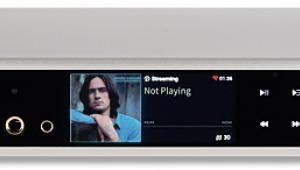PS Audio DirectStream DAC 2 USB DAC

 It's arguable that the best high-end DACs all feature custom upsampling and conversion architectures – nothing 'off the shelf'! PS Audio has been part of the club for a decade...
It's arguable that the best high-end DACs all feature custom upsampling and conversion architectures – nothing 'off the shelf'! PS Audio has been part of the club for a decade...
All good things come to an end, although in the world of digital hi-fi sometimes that end comes around pretty quickly. Obsolescence isn't as 'built-in' here as it is in the smartphone market, for example, but technological evolutions, be they around chipsets, connection standards or format types, mean 'MK2' iterations of DACs and streaming hardware are a common sight. PS Audio's DirectStream DAC MK2, however, is rather more than a mere second-generation product.
This is because the original DirectStream DAC, launched nearly a decade ago [HFN Aug '14], was upgraded many times during its lifetime through software updates and new 'Mountaintop' operating systems. Like fellow premium DAC manufacturers Chord, dCS and MSB Technology, Colorado's PS Audio favours its own bespoke implementation, eschewing off-the-shelf chips from third-party suppliers and instead writing its own custom code to an FPGA. This opens up a world of flexibility that most other DAC makers don't enjoy, and PS Audio hasn't been shy about exploring it.
Back In Control
Over the years, the DirectStream DAC was enhanced with new functionality, PS Audio's upgrade programme touted as 'a new DAC for free'. For example, the final OS update, to 'Sunlight' in 2021, expanded file compatibility over the I2S connection to quad-rate DSD while improving sound performance. Now, however, the company and its designer Ted Smith have reached the end of that particular road, and the result is a relaunch of the company's flagship outboard converter, priced £7999.

The most obvious outward change appears to be something of a step back, as the DirectStream DAC MK2 jettisons the touchscreen of the original for a smaller display and adjacent bank of control buttons. This combination arguably makes the DAC, which features PS Audio's now-familiar black or silver casework and robust build, look like a classier product, and it still offers key information (selected input, file format, etc) as well as access to the DAC's user features. These include balance adjustment, phase inversion, a de-emphasis filter (for CD playback) and setting the default volume level or fixing the output. You can also select which FPGA 'load' to run, allowing for A/B comparisons and the accommodation of personal taste.
PS Audio says 'everything the DS can do, the DS MK2 can do better', and to achieve this it has totally rethought the internal design with upgrades to the power distribution, main PCB layout, output transformers and op-amps – the latter claiming 'lower distortion, more current capability, better power supply noise rejection and firmer bass response'.
Spartan Army
The FPGA chip count has also increased from one to two (though only one is apparently in use at the outset), and moved to the latest Spartan 7 iteration from Xilinx. Moreover, all the device's inputs and outputs are now galvanically isolated.
There's a somewhat different view around the back too, as PS Audio has expanded the connection options. Digital inputs are still on two HDMI/I2S ports, optical and coaxial, USB-B and balanced AES/XLR, but there are now two of the latter, enabling a ganged input for double-rate DSD. The unit has also lost the SD Card slot of its predecessor (used for uploading new firmware) and replaced it here with Wi-Fi and wired Ethernet/LAN ports.
Previously these options were added via PS Audio's Network Bridge II card, which transformed it into a streaming DAC, but the DirectStream DAC MK2 is instead designed to partner the company's forthcoming 'Air Lens' streamer. This will offer a galvanically isolated I2S connection with the 'Digital Lens' output buffering/isolation technology featured on the PerfectWave SACD Transport – another potential partner that allows for a native DSD output from SACD.
The MK2 will also handle PCM files to 705.6kHz, and DSD256, over USB-B but what has evolved, rather than changed, is PS Audio's bespoke approach to D/A conversion. With all inputs upsampled to a very high-rate DSD, noise-shaped and filtered, this DAC offers a unique technical and subjective performance.

























































